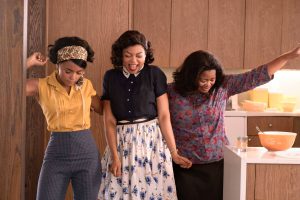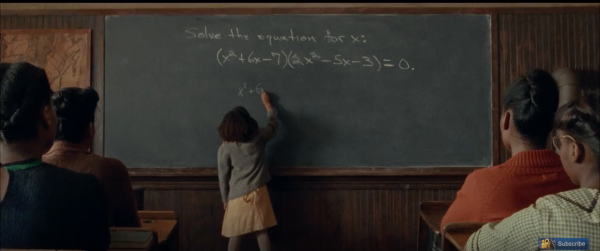 Mega-late to the party, I’ve now arrived back from a week lecturing in Indonesia and have found time to go and see the incredibly well-received and widely talked-about NASA women maths film, Hidden Figures. I’ve heard an incredible number of wildly positive responses to the film, from as long ago as January, and have been looking forward to it greatly.
Mega-late to the party, I’ve now arrived back from a week lecturing in Indonesia and have found time to go and see the incredibly well-received and widely talked-about NASA women maths film, Hidden Figures. I’ve heard an incredible number of wildly positive responses to the film, from as long ago as January, and have been looking forward to it greatly.
The film is a painstaking and at times brutally realistic depiction of the struggles faced by African-Americans, and by women, during the era of the early space missions.
It’s the first film I’ve ever seen where the BBFC certificate at the start warns, where you’d usually see “scenes of violence/nudity/strong language”, a warning for “discrimination theme” – and it’s justified, as you find yourself battered by the repeatedly unfair and horrible treatment received by the clearly brilliant and lovely main characters, and worst of all how that is completely normal and widespread for the time. Langley, where NASA HQ is located, is in Virginia, a state where segregation continued in many aspects until the Civil Rights Act of 1964 – this meant ‘coloureds’ had to use separate bathrooms, drink from separate water fountains, sit in a separate section at the back of the bus and attend separate schools, all of which (and their horrible demoralising effects) are seen clearly in the film.
It also doesn’t shy away from the discrimination received by women, which is another layer of problems these characters face – even within their own community, they encounter people with a ‘do they let women do that?’ attitude. When one character arrives in her new department to provide her mathematical expertise and is immediately handed a bin which needs emptying, it’s not clear whether it’s because she’s female or black (or both).
But you’re here for the maths, right? This is at its core a film about a mathematician, an engineer and a computer scientist and how they helped America put a man into space. The maths and science is well incorporated into the story and doesn’t feel awkward, and serves to display the brilliance of the main characters, as well as the difficulty of the work everyone at NASA was doing – it was groundbreaking, and in some cases involved inventing new mathematical techniques to solve problems nobody imagined they’d have to solve (and this aspect of the space race is even mentioned as a justification for the huge cost and effort of the programme).

In one early scene, Katherine Johnson (as a child) demonstrates her mathematical brilliance by, having skipped two grades in school, being called up to the blackboard in front of a room of older students. She demonstrates that the product of two quadratics, set equal to zero on the board, can easily be solved by noting that if a product of two things equals zero, it means one of the two terms must equal zero so you can factorise each of the two quadratics, set each of the four resulting components to zero and find four solutions. It’s a beautiful piece of maths, well explained and displayed in full, front and centre in the scene. While some filmmakers might worry about this, it completely works and demonstrates her brilliance – the looks on the other students’ faces tell the story too.
Elsewhere in the film, Katherine is required to do Analytic Geometry, studying the trajectories of the space flights and their take-off and landing. The initial calculations for the earlier low-Earth orbit flights were simpler, and it’s when they start considering the more complex orbital flights – in which the trajectory of the capsule changes from an elliptical orbit of the Earth to a parabolic trajectory as it comes down, where they needed to work out something new. Together the team realises they can use numerical integration – Euler’s Method, which has been known for a long time but hadn’t been used at NASA for years – to obtain a solution which works numerically, without having to actually solve the differential equations. Johnson’s brilliance in helping come to this realisation is clear, and anyone watching who didn’t understand the maths can maybe even get a sense of the beauty and satisfaction mathematicians find in their work, especially when it has such amazing applications.
The other main characters demonstrate their excellence in their own fields too. Mary Jackson, clearly a brilliant engineer, is encouraged by her boss to join the NASA engineer training programme, but finds her bachelor’s degree in maths and physics is insufficient; the administrator’s veiled joy in telling her she doesn’t qualify could just be a true bureaucrat relishing in the rules, but as with many of the things people do in the film it’s in line with the standards of the era, and advancement seems an impossible dream.
The third amazing role model in this film is Dorothy Vaughan, who runs the computing department (at the time, a team of human ‘computers’ who perform all the calculations by hand). She notices that the new IBM supercomputer coming in to do the calculations will make all their jobs obsolete, so she educates herself and her team, getting books on Fortran from the library and using her skills with machinery and numbers to understand how it works.
I’m glad this film exists, and I’m double glad that it’s such a well-made piece of cinema, with well-developed characters, a gripping story and emotional tugs which work regardless of whether you’re interested in maths – because it means lots of people will see it. I hope that as well as telling these women’s stories – something badly needed – and reminding us of how painfully recent these attitudes held sway (and warning us not to let them take hold again now!) this film will also help people to see the wonder of maths and science, and show that people who do these things struggle the same as everyone else, and are all part of the same world.
It looks like the film is having this effect – many people are now talking about it, and Katherine Johnson also features in this new LEGO set, recently approved, of Women Pioneers at NASA. I’d recommend going to see it, but also taking along some tissues and being prepared to come out energised and angry that people were treated this way, and, I’d hope, ready to take on injustice now.
As good as the movie is, the book is better. Some of the scenes in the movie are fictionalized. (And they left out some dramatic scenes from the book, sadly.) I was mad the first time I watched it. (One scene feels like the white savior motif to me, and is not true, to my knowledge.) The second time I watched it, I could enjoy it more. And I’m planning to see it a third time, with my niece who wants to see it with ‘the woman who got her interested in math.’